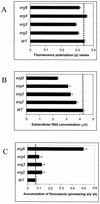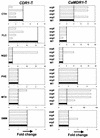Drug susceptibilities of yeast cells are affected by membrane lipid composition
- PMID: 12435664
- PMCID: PMC132749
- DOI: 10.1128/AAC.46.12.3695-3705.2002
Drug susceptibilities of yeast cells are affected by membrane lipid composition
Abstract
In the present study we have exploited isogenic erg mutants of Saccharomyces cerevisiae to examine the contribution of an altered lipid environment on drug susceptibilities of yeast cells. It is observed that erg mutants, which possess high levels of membrane fluidity, were hypersensitive to the drugs tested, i.e., cycloheximide (CYH), o-phenanthroline, sulfomethuron methyl, 4-nitroquinoline oxide, and methotrexate. Most of the erg mutants except mutant erg4 were, however, resistant to fluconazole (FLC). By using the fluorophore rhodamine-6G and radiolabeled FLC to monitor the passive diffusion, it was observed that erg mutant cells elicited enhanced diffusion. The addition of a membrane fluidizer, benzyl alcohol (BA), to S. cerevisiae wild-type cells led to enhanced membrane fluidity. However, a 10 to 12% increase in BA-induced membrane fluidity did not alter the drug susceptibilities of the S. cerevisiae wild-type cells. The enhanced diffusion observed in erg mutants did not seem to be solely responsible for the observed hypersensitivity of erg mutants. In order to ascertain the functioning of drug extrusion pumps encoding the genes CDR1 (ATP-binding cassette family) and CaMDR1 (MFS family) of Candida albicans in a different lipid environment, they were independently expressed in an S. cerevisiae erg mutant background. While the fold change in drug resistance mediated by CaMDR1 remained the same or increased in erg mutants, susceptibility to FLC and CYH mediated by CDR1 was increased (decrease in fold resistance). Our results demonstrate that between the two drug extrusion pumps, Cdr1p appeared to be more adversely affected by the fluctuations in the membrane lipid environment (particularly to ergosterol). By using 6-[(7-nitrobenz-2-oxa-1,3-diazol-4-yl) amino-hexanoyl] sphingosyl phosphocholine (a fluorescent analogue of sphingomyelin), a close interaction between membrane ergosterol and sphingomyelin which appears to be disrupted in erg mutants is demonstrated. Taken together it appears that multidrug resistance in yeast is closely linked to the status of membrane lipids, wherein the overall drug susceptibility phenotype of a cell appears to be an interplay among drug diffusion, extrusion pumps, and the membrane lipid environment.
Figures







Similar articles
-
Membrane sphingolipid-ergosterol interactions are important determinants of multidrug resistance in Candida albicans.Antimicrob Agents Chemother. 2004 May;48(5):1778-87. doi: 10.1128/AAC.48.5.1778-1787.2004. Antimicrob Agents Chemother. 2004. PMID: 15105135 Free PMC article.
-
Membrane fluidity affects functions of Cdr1p, a multidrug ABC transporter of Candida albicans.FEMS Microbiol Lett. 1999 Apr 15;173(2):475-81. doi: 10.1111/j.1574-6968.1999.tb13541.x. FEMS Microbiol Lett. 1999. PMID: 10227177
-
The yeast multidrug resistance pump, Pdr5p, confers reduced drug resistance in erg mutants of Saccharomyces cerevisiae.Microbiology (Reading). 1999 Apr;145 ( Pt 4):809-818. doi: 10.1099/13500872-145-4-809. Microbiology (Reading). 1999. PMID: 10220160
-
The synthesis, regulation, and functions of sterols in Candida albicans: Well-known but still lots to learn.Virulence. 2016 Aug 17;7(6):649-59. doi: 10.1080/21505594.2016.1188236. Epub 2016 May 24. Virulence. 2016. PMID: 27221657 Free PMC article. Review.
-
Regulation of Ergosterol Biosynthesis in Saccharomyces cerevisiae.Genes (Basel). 2020 Jul 15;11(7):795. doi: 10.3390/genes11070795. Genes (Basel). 2020. PMID: 32679672 Free PMC article. Review.
Cited by
-
Comparative lipidomics in clinical isolates of Candida albicans reveal crosstalk between mitochondria, cell wall integrity and azole resistance.PLoS One. 2012;7(6):e39812. doi: 10.1371/journal.pone.0039812. Epub 2012 Jun 27. PLoS One. 2012. PMID: 22761908 Free PMC article.
-
Calcineurin signaling and membrane lipid homeostasis regulates iron mediated multidrug resistance mechanisms in Candida albicans.PLoS One. 2011 Apr 12;6(4):e18684. doi: 10.1371/journal.pone.0018684. PLoS One. 2011. PMID: 21533276 Free PMC article.
-
Molecular mechanisms of action of herbal antifungal alkaloid berberine, in Candida albicans.PLoS One. 2014 Aug 8;9(8):e104554. doi: 10.1371/journal.pone.0104554. eCollection 2014. PLoS One. 2014. PMID: 25105295 Free PMC article.
-
Multi-omics Signature of Candida auris, an Emerging and Multidrug-Resistant Pathogen.mSystems. 2019 Jun 11;4(4):e00257-19. doi: 10.1128/mSystems.00257-19. mSystems. 2019. PMID: 31186339 Free PMC article.
-
Widespread Genetic Incompatibilities between First-Step Mutations during Parallel Adaptation of Saccharomyces cerevisiae to a Common Environment.PLoS Biol. 2017 Jan 23;15(1):e1002591. doi: 10.1371/journal.pbio.1002591. eCollection 2017 Jan. PLoS Biol. 2017. PMID: 28114370 Free PMC article.
References
-
- Ansari, S., P. Gupta, S. K. Mahanty, and R. Prasad. 1993. The uptake of amino acids by erg mutants of Candida albicans. J. Med. Vet. Mycol. 31:377-386.
-
- Arthington-Skaggs, B., W. Lee-Yang, M. A. Ciblak, J. P. Frade, M. E. Brandt, R. A. Hajjeh, L. H. Harrison, A. N. Sofair, and D. W. Warnock. 2002. Comparison of visual and spectrophotometric methods of broth microdilution MIC end point determination and evaluation of a sterol quantitation method for in vitro susceptibility testing of fluconazole and itraconazole against trailing and nontrailing Candida isolates. Antimicrob. Agents Chemother. 46:2477-2481. - PMC - PubMed
-
- Debry, P., E. A. Nash, D. W. Nekalson, and J. E. Metherall. 1997. Role of multidrug resistance P-glycoproteins in cholesterol esterification. J. Biol. Chem. 272:1026-1031. - PubMed
Publication types
MeSH terms
Substances
LinkOut - more resources
Full Text Sources
Molecular Biology Databases

